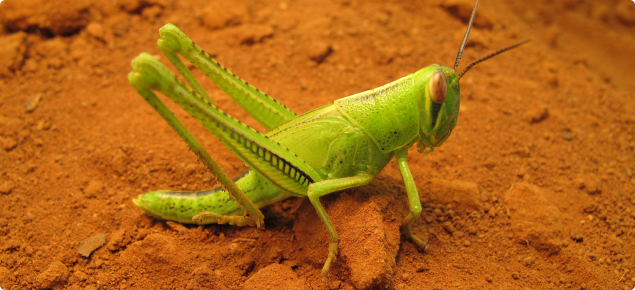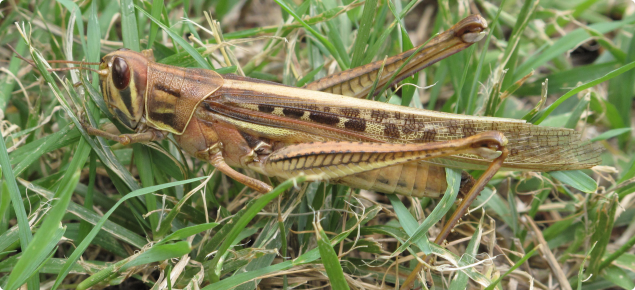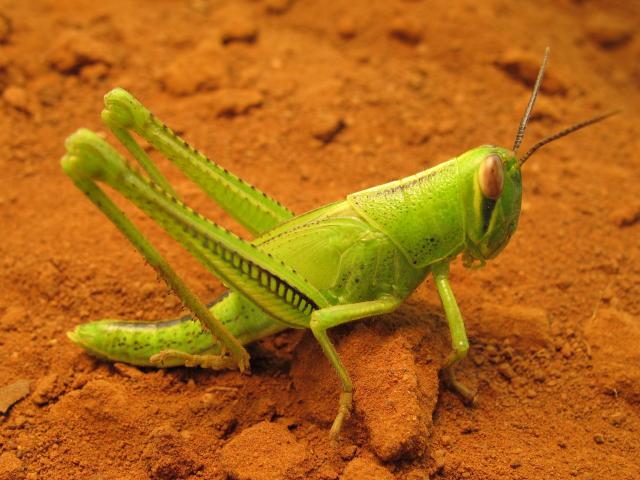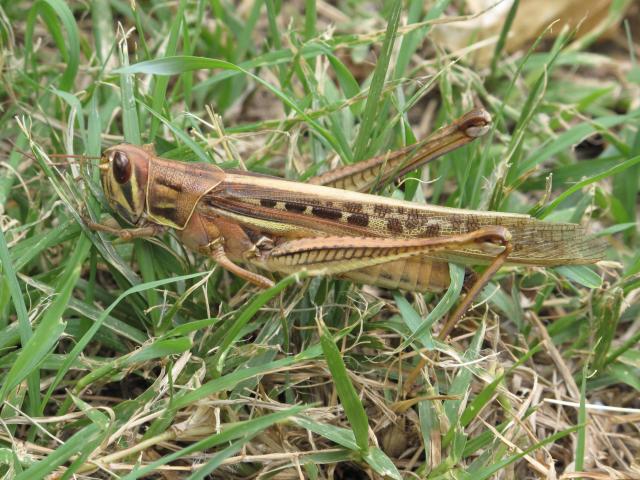Introduction
Spur-throated locust Austracris guttulosa is a pest of pastures, crops and certain tree species. It is a sub-tropical species of northern Australia, but extends its habitat into areas experiencing wet summer seasons.
Description
The spur-throated locust is readily distinguished from other pest species of locusts and grasshoppers by its large size and the presence of a spur, or throat-peg, between the front legs. The adults are pale brown in colour with white stripes and dark markings on the thorax. The hind-wings are colourless or have a bluish tinge. The shanks of the hind legs are straw or mauve coloured and bear two rows of dark-tipped white spines. Adult males measure 55–65mm long and females are 70–80mm long.
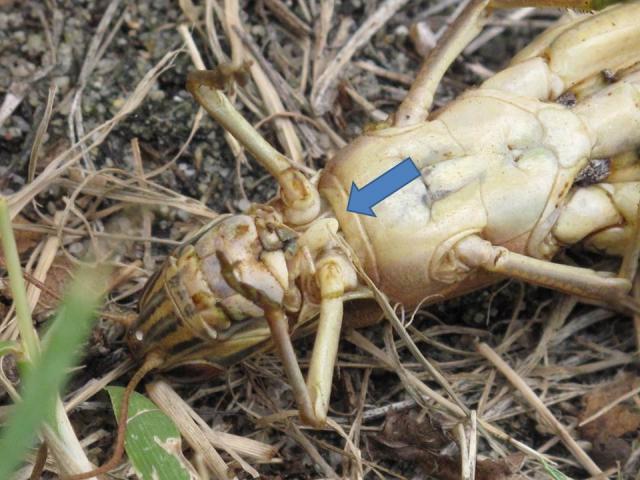
Young nymphs are bright green. Older nymphs have a distinct pale or dark stripe down the middle of their back and often change in colour from green to straw coloured.
Biology
Number of generations
The spur-throated locust has one generation per year. Adult locusts live 10–12 months, from autumn of one year until the following summer.
Egg laying and development
Spur-throated locusts spend the autumn and winter as immature adults. If there has been sufficient spring rainfall, egg maturation inside female locusts begins and eggs are laid from October to November. Egg laying lasts two to three months and females die after laying eggs. If there is no spring rainfall, spur-throated locusts may migrate or they may not lay eggs until there is rainfall which can be as late as February or even March. Female spur-throated locust lay eggs in batches, called pods, in the soil. Females can lay up to 130 eggs in a pod and can lay up to four pods. Unlike the Australian plague locust, eggs are not laid in egg-beds, but are laid over a wider area, although females tend to lay near areas of short grass.
Eggs laid in moist soil take 20 to 30 days to develop depending on warm temperatures (30–35°C), under cooler conditions (22°C) it can take up to 62 days. Eggs laid in dry soil enter a quiescent (resting) state and do not hatch until further rain falls. Spur-throated locust eggs are not able to stay in quiescence for prolonged periods and many die if dry soil conditions continue for more than a month.
Nymphs
An immature locust is called a nymph or hopper. After hatching spur-throated locust go through six to eight nymphal growth stages called instars, moulting at each stage. The developing wings become more noticeable at each stage until the locust becomes a fledgling adult and then an immature adult capable of sustained flight. Nymphs take 10 weeks to reach adult stage, under normal summer temperatures.
Colour of nymphs is variable. Early instars tend to be green, with variations in later instars of yellow and straw through to grey. Like the adults, later instars tend to have a distinct pale or dark stripe down the middle of their back.
From the third instar onwards nymphs are quite large and can damage crops. Nymphs are usually present from December—March, but if hatching is late, nymphs can be present well into autumn. Nymphs do not form high density bands although they can be found in high densities in preferred grasses and herbage. Young nymphs are most common in short grasses and ephemeral plants while older nymphs are found in taller vegetation
Early instar nymphs require suitable green plant material to survive and develop into adults.
Adults
Fledging (development of nymphs into winged adults) usually occurs during March—April but can occur as early as January when there has been early egg laying. Newly fledged adults enter a sexual diapause stage, where reproductive development is delayed. During winter these adults tend to move in to timbered areas, forming very dense roosting swarms. They may move down to feed on the vegetation below the trees during the warmer part of the day. The overwintering state is maintained until increasing photoperiod and temperatures, trigger migration behaviour. Sexual diapause is broken after spring rainfall and it takes 15 days for male and 20 days for female adults to reach sexual maturity (may be longer in cooler temperatures). Egg laying can then commence from late October (typically seven to nine months after fledging).
Migration
Sexually mature spur-throated locusts can undertake nocturnal, wind-assisted, long distance migrations from between October and January, often associated with the passage of tropical depressions. Migrations of 700–1000km have been reported. These migrations can result in major redistributions of population.
During the autumn and winter period, fledging, young adults form swarms that in daylight migrate shorter distances (up to 20km per day). This flight activity may result in only a short migration or populations may move substantial distances during the autumn and winter months.
Distribution
The major breeding areas of the spur-throated locust are in the Gulf region of northern Australia in monsoonal tropical grasslands, which includes the northern regions of Western Australia. The climate of the northern region is characterised by a distinct summer wet season and a winter dry season, with breeding extending into southern areas only after successive seasons of summer rainfall.
Management
Damage
Nymphs and adults are voracious eaters. Generally, nymphal densities of 20 per m² or greater will pose an economic threat to crops. Adults, 1–3 per m², have caused economic damage to sorghum and sunflowers.
Nymphs and adults feed on green vegetation. Nymphs can damage crops in autumn but during autumn-winter, crops are most at risk from fledging adults. The amount of crop damage will depend on numbers of locusts that are present in the vicinity of the crop and on migrations into crops. Adults will feed on wheat and canola as well as various types of trees including natives, ornamentals, citrus and fruit. Damage in spring has been recorded in ripening wheat crops.
The amount of damage spur-throated locusts cause to crops depends on temperature, as these locusts are less active in cool conditions, however frosts will not cause mortality. Spur-throated locusts are known to feed on crops when temperatures are at or above 15°C, it is also likely that they will be able to feed on crops when temperatures are below 15°C if there is sufficient sunshine.
Control
Nymph control is generally not economically viable except in and around high-value crops. The nymphs do not band and are generally quite scattered, at densities less than 20 per m². Nymphs generally move into crop from adjoining pasture or native habitat. Effective nymph control will only be achieved if the crop and adjoining pasture or native habitat is treated. If the adjoining pasture or native habitat is not controlled, reinvasion can occur within days. Lower rates of registered insecticides listed below have efficacy on nymphs and these can be applied using a ground-rig. There are reports that synthetic pyrethroids applied at the highest registered rate will control early instar nymphs.
Adult locusts in medium (11-50 per m²) to high (>50 per m²) density swarms pose a significant economic threat. The most effective control is achieved by aerial spraying of swarms that are roosting in trees. Spraying crops and pastures with contact insecticides using a ground-rig will provide very limited control of spur-throated locust adults, as adults are very good fliers and are able to escape from ground-rig applications. Spraying with residual insecticides may provide better control but this relies on adult locusts coming into contact with lethal doses of insecticides from the crops they are invading and, therefore, may not prevent crop damage.
A number of pesticides are registered for the control of spur-throated locust. All control should be done as per the label instructions. If a pesticide is registered for use in Western Australia on a crop for the control of a pest, an agricultural user may use the pesticide on that crop for the control of any pest provided withholding periods and all other limitations are observed.
Below are the insecticides that have efficacy on spur throated locusts, the higher rate should be used against adults. Check that the rates listed below are registered for use on crops on which control is required.
| Chemical | Registered rate (mL/ha) |
|---|---|
| Chlorpyrifos | 1250 or 1500 |
| Diazinon | 700–850 |
| Fenitrothion | 270–550 |
| Fenitrothion (ULV) | 200-400 |
| Fipronil | 6.25 |
| Metarhizium SC (Green Guard) | 500mL in 75-225L of water |
| Metarhizium ULV (Green Guard) | 250 |
Acknowledgements
Information used in this publication has been supplied by the Australian Plague Locust Commission.

